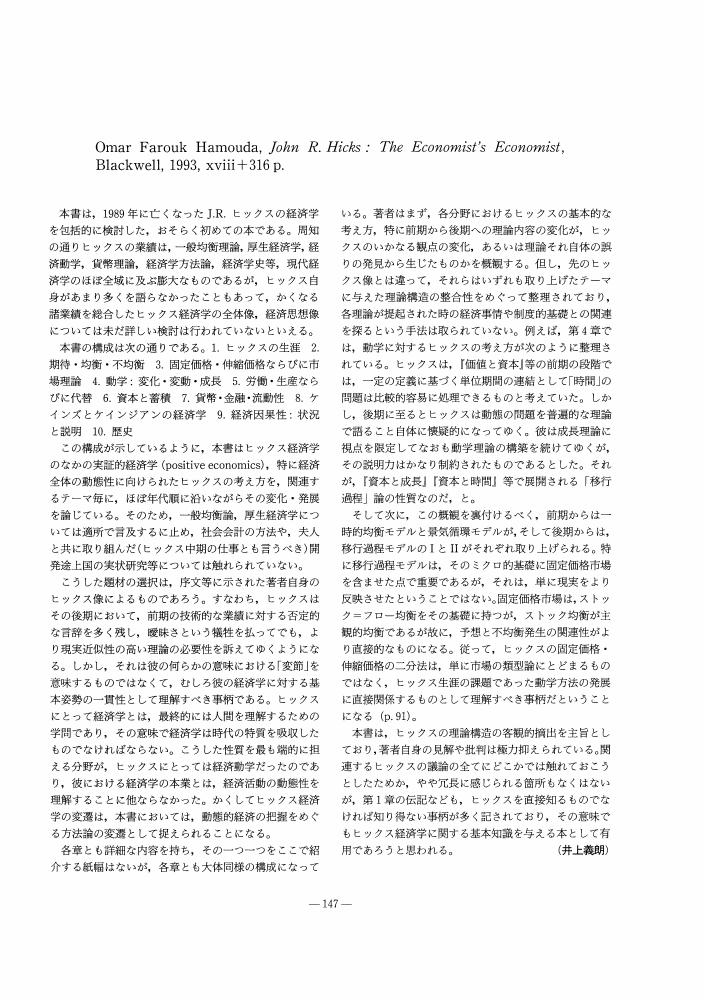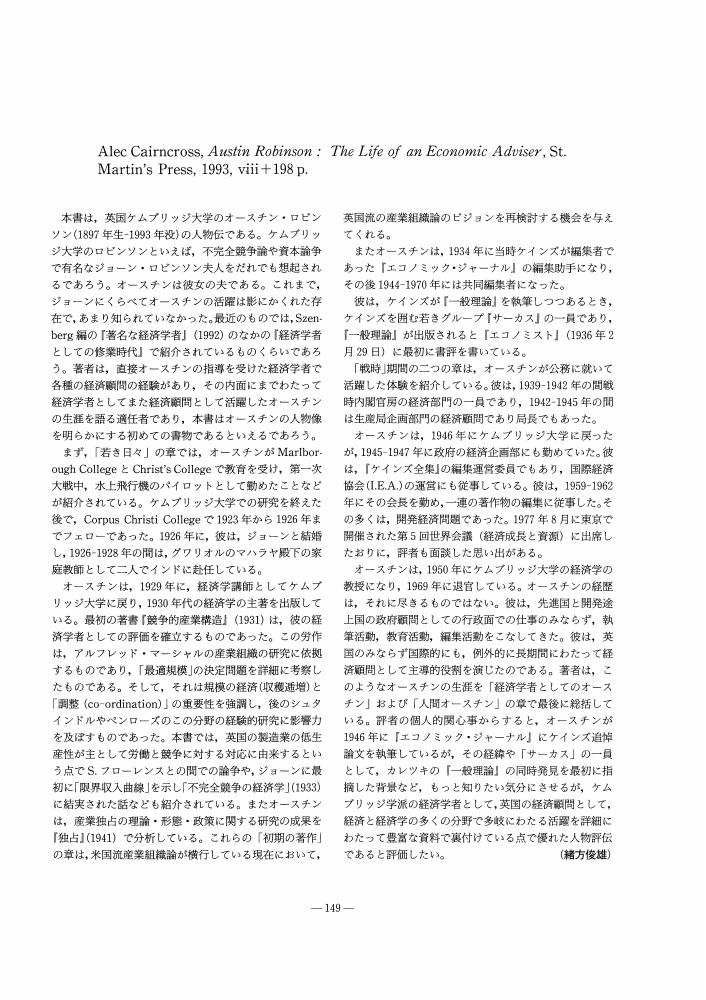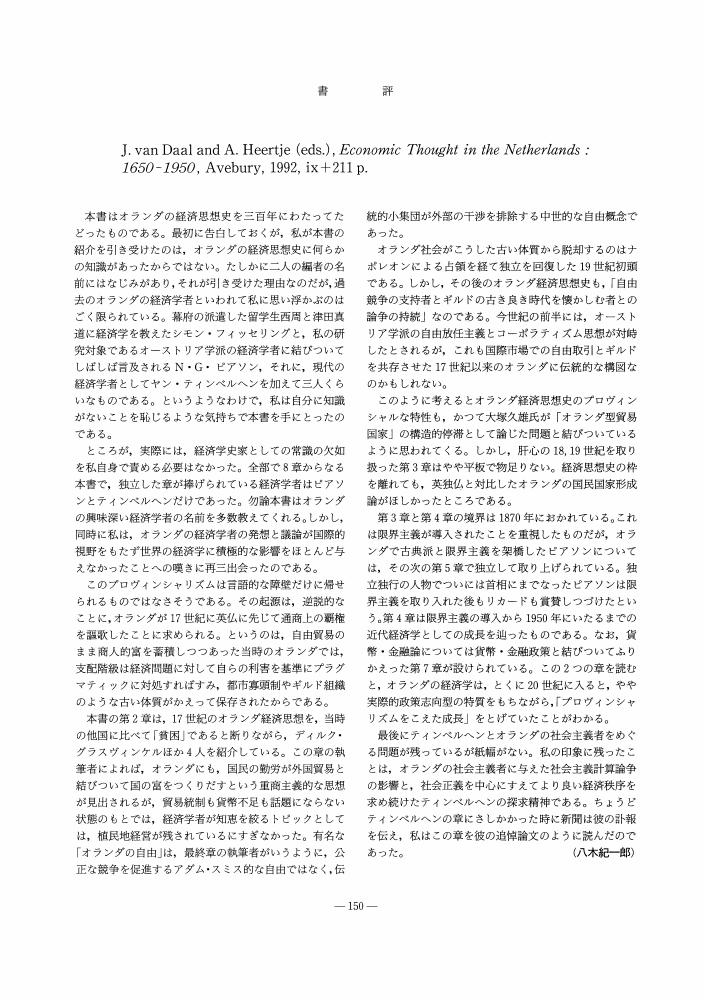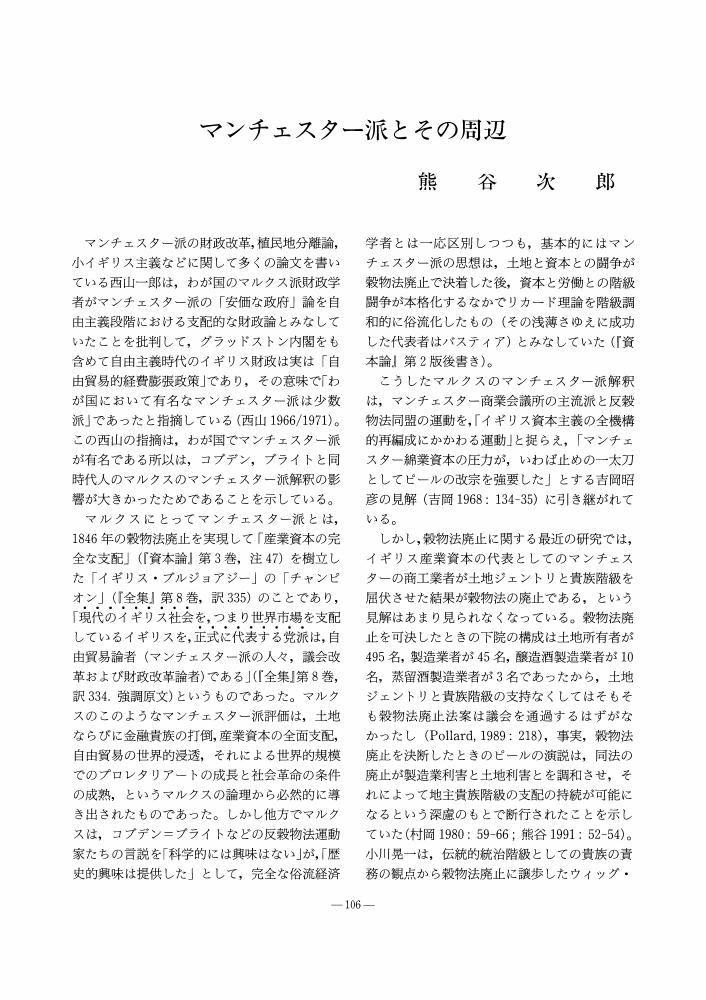1 0 0 0 OA Omar Farouk Hamouda, John R. Hicks: The Economist's Economist, Blackwell, 1993, xviii+316p.
- 著者
- 井上 義朗
- 出版者
- The Japanese Society for the History of Economic Thought
- 雑誌
- 経済学史学会年報 (ISSN:04534786)
- 巻号頁・発行日
- vol.32, no.32, pp.147, 1994 (Released:2010-08-05)
- 著者
- 西沢 保
- 出版者
- The Japanese Society for the History of Economic Thought
- 雑誌
- 経済学史学会年報 (ISSN:04534786)
- 巻号頁・発行日
- vol.32, no.32, pp.148, 1994 (Released:2010-08-05)
- 著者
- 緒方 俊雄
- 出版者
- The Japanese Society for the History of Economic Thought
- 雑誌
- 経済学史学会年報 (ISSN:04534786)
- 巻号頁・発行日
- vol.32, no.32, pp.149, 1994 (Released:2010-08-05)
- 著者
- 八木 紀一郎
- 出版者
- The Japanese Society for the History of Economic Thought
- 雑誌
- 経済学史学会年報 (ISSN:04534786)
- 巻号頁・発行日
- vol.32, no.32, pp.150, 1994 (Released:2010-08-05)
- 著者
- 塘 茂樹
- 出版者
- The Japanese Society for the History of Economic Thought
- 雑誌
- 経済学史学会年報 (ISSN:04534786)
- 巻号頁・発行日
- vol.32, no.32, pp.151, 1994 (Released:2010-08-05)
1 0 0 0 OA ヒューム社会科学の歴史像
- 著者
- 坂本 達哉
- 出版者
- The Japanese Society for the History of Economic Thought
- 雑誌
- 経済学史学会年報 (ISSN:04534786)
- 巻号頁・発行日
- vol.32, no.32, pp.99-105, 1994 (Released:2010-08-05)
- 参考文献数
- 54
1 0 0 0 OA マンチェスター派とその周辺
- 著者
- 熊谷 次郎
- 出版者
- The Japanese Society for the History of Economic Thought
- 雑誌
- 経済学史学会年報 (ISSN:04534786)
- 巻号頁・発行日
- vol.32, no.32, pp.106-113, 1994 (Released:2010-08-05)
- 参考文献数
- 54
1 0 0 0 OA 欧米における最近のマルクス経済学の展開
- 著者
- 千賀 重義
- 出版者
- The Japanese Society for the History of Economic Thought
- 雑誌
- 経済学史学会年報 (ISSN:04534786)
- 巻号頁・発行日
- vol.32, no.32, pp.114-120, 1994 (Released:2010-08-05)
- 参考文献数
- 20
1 0 0 0 OA 『一般理論』形成史研究の現在
- 著者
- 藤井 賢治
- 出版者
- The Japanese Society for the History of Economic Thought
- 雑誌
- 経済学史学会年報 (ISSN:04534786)
- 巻号頁・発行日
- vol.32, no.32, pp.121-126, 1994 (Released:2010-08-05)
- 参考文献数
- 27
1 0 0 0 OA 経済学と環境問題
- 著者
- 工藤 秀明
- 出版者
- The Japanese Society for the History of Economic Thought
- 雑誌
- 経済学史学会年報 (ISSN:04534786)
- 巻号頁・発行日
- vol.32, no.32, pp.127-136, 1994 (Released:2010-08-05)
- 参考文献数
- 62
- 著者
- 鈴木 信雄
- 出版者
- The Japanese Society for the History of Economic Thought
- 雑誌
- 経済学史学会年報 (ISSN:04534786)
- 巻号頁・発行日
- vol.32, no.32, pp.137, 1994 (Released:2010-08-05)
- 著者
- 有江 大介
- 出版者
- The Japanese Society for the History of Economic Thought
- 雑誌
- 経済学史学会年報 (ISSN:04534786)
- 巻号頁・発行日
- vol.32, no.32, pp.138, 1994 (Released:2010-08-05)
1 0 0 0 OA Takumi Tsuda (éd.), Mémoires et Lettres de Vincent de Gournay, Kinokuniya Company, 1993, xxxv+230p.
- 著者
- 大田 一廣
- 出版者
- The Japanese Society for the History of Economic Thought
- 雑誌
- 経済学史学会年報 (ISSN:04534786)
- 巻号頁・発行日
- vol.32, no.32, pp.139, 1994 (Released:2010-08-05)
- 著者
- 出雲 雅志
- 出版者
- The Japanese Society for the History of Economic Thought
- 雑誌
- 経済学史学会年報 (ISSN:04534786)
- 巻号頁・発行日
- vol.32, no.32, pp.140-141, 1994 (Released:2010-08-05)
- 著者
- 野口 旭
- 出版者
- The Japanese Society for the History of Economic Thought
- 雑誌
- 経済学史学会年報 (ISSN:04534786)
- 巻号頁・発行日
- vol.32, no.32, pp.142, 1994 (Released:2010-08-05)
1 0 0 0 OA 貨幣的分析の諸相とヘンリー・ソーントン
- 著者
- 水田 健
- 出版者
- The Japanese Society for the History of Economic Thought
- 雑誌
- 経済学史学会年報 (ISSN:04534786)
- 巻号頁・発行日
- vol.32, no.32, pp.16-27, 1994 (Released:2010-08-05)
- 参考文献数
- 24
There are some types of money market models in the history of economic theory. They are the quantity theory of money, the Keynesian approach and the Banking School theory. The object of the present article is to place Thornton in the proper position among those theories.His theory is included in the quantity theory. It is true that he instists on the theory in his Paper Credit, but he also mentions the effect of money on the real variables in an economy. However, that is true of other quantity theorists, such as Hume and Fisher. They recognize that changes in the quantity of money affect output and employment in the short run, while emphasizing that the price level is determined only by the money supply in the long run. Therefore, Thornton is in the same camp as they.He also belongs to the Wicksellian stream, which begins with Thornton, followed by Ricardo, Joplin and so on, and then reaches to Wicksell. According to the argument, changes in the money stock originate from a disparity between the rate of interest and the rate of profit.
1 0 0 0 OA 貨幣的経済理論史におけるリカードウとヴィクセル
- 著者
- 岡田 元浩
- 出版者
- The Japanese Society for the History of Economic Thought
- 雑誌
- 経済学史学会年報 (ISSN:04534786)
- 巻号頁・発行日
- vol.32, no.32, pp.28-39, 1994 (Released:2010-08-05)
- 参考文献数
- 26
This paper expounds the characteristics of both D. Ricardo's and K. Wicksell's theory of monetary economy. By comparing them, we find a clue to the re-examination of the history of macroeconomics from classical economists to J. M. Keynes.Wicksell, a pioneer of 20th century's macroeconomics, had a great respect for Ricardo's view of prices, and regarded it as the starting point of his own theory, in spite of his several criticisms of it. Indeed, Ricardo's view anticipated that of Wicksell more than Wicksell realized. We can cofirm this in Ricardo's comment on the relation of interest to price movements and the role of the banking system in it. While Wicksell is often referred to as a forerunner of Keynes, we are apt to take Ricardo merely as a proponent of Say's law and quantity theory of money, and hence the founder of ‘classics’ as Keynes said. But, after the above consideration, we ought to revalue Ricardo's view, and place it in the origin of the stream of thought which developed, via Wicksell's theory of price fluctuations, into Keynes's General Theory.
- 著者
- Takashi NEGISHI
- 出版者
- The Japanese Society for the History of Economic Thought
- 雑誌
- 経済学史学会年報 (ISSN:04534786)
- 巻号頁・発行日
- vol.32, no.32, pp.40-47, 1994 (Released:2010-08-05)
- 参考文献数
- 13
In his Wealth of Nations (1776), Adam Smith still emphasized the effects of the division of labour, which he had tried to demonstrate by numerical exampes in the Early Draft (1763). By the use of our Smithian growth model of a capitalistic economy—with a balanced growth path, in which Adam Smith's natural prices and natural wages are realized—we can show that a further division of labour in the production of a commodity reduces its natural price and increases the natural rate of wages and profit. It is also demonstrated that Smith's numerical examples in the Early Draft can be generated from the growth model within his Wealth of Nations.
1 0 0 0 OA アダム・スミスとストア哲学
- 著者
- 伊藤 哲
- 出版者
- The Japanese Society for the History of Economic Thought
- 雑誌
- 経済学史学会年報 (ISSN:04534786)
- 巻号頁・発行日
- vol.32, no.32, pp.48-59, 1994 (Released:2010-08-05)
This article intends to reconsider the relationship between stoic philosophy and the theory of self-command in The Theory of Moral Sentiments.Hitherto, in Western studies, it has been thought that Smith had treated stoic philosophy consistently from the first edition to the sixth edition. However, in my view, concerning the theory of self-command, Smith seemed to criticize stoic philosophy in the sixth edition.In the first edition (1759), Smith comprehended that the virtue of perfect self-command was regarded as stoical heroism or, as it were, stoic virtue. In addition, he realized that the impartial spectator had to maintain a stoic magnanimity. Moreover, in the second edition (1761), according to the supplement of Epictetus' quotation in Part III, Smith emphasized stoic virtue as a means towards of the perfection of human nature. Therefore, with regard to the perfection of human nature, Smith recognized self-command as an integral part of the theory of virtue. However, in the sixth edition (1790), Smith evidently criticized the stoical apathy, which is not true self-command but lack of sensibility. Smith noticed that it was so dangerous to restrain the natural course of passions, and that the habitual most perfect self-command, though it was acquired via many hardships, might tend to fall into insensibility. Hence, Smith pointed out the proper relationship between self-command and sensibility in practical morality.
1 0 0 0 OA ソーントン『紙券信用論』の可能性
- 著者
- 大黒 弘慈
- 出版者
- The Japanese Society for the History of Economic Thought
- 雑誌
- 経済学史学会年報 (ISSN:04534786)
- 巻号頁・発行日
- vol.32, no.32, pp.60-73, 1994 (Released:2010-08-05)
- 参考文献数
- 17
H. Thornton is often regarded as a minor immature Ricardo with regard to his quantity theory. But he should not be neglected as a mere ‘intermediate link’ between Smith and Ricardo, who narrowed the contents of the credit theory of Smith. While both Smith and Ricardo confused credit with money as a means of circulation, Thornton clarified the special character of credit money as a means of payment and attempted to apply the law of‘Necessary Amount of Money’ to credit money. These points of view were in a sense similar to Marx's.Thornton also investigated the interaction between money and production, and did not isolate credit phenomena from the production process. In doing so, he found that the optimal amount of money can be reached not in natural course of automatic adjustment mechanism of the market i. e. the Law of Reflux, but by means of flexible intervention by the Bank of England.Thornton's originality can be found in his analysis of the following two points. One is the discretionary control by the Bank of England through the operation of various political judgemets. The other is the refinement of the law of ‘Necessary Amount of Money’. This paper tries to explore Thornton's analysis of the nature and the basis of circulation of credit money, and thus tries to fill the ‘missing link’ between Thornton and Marx.














